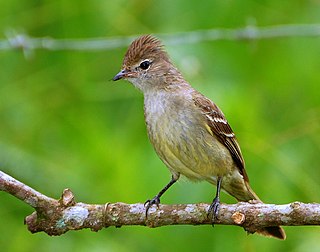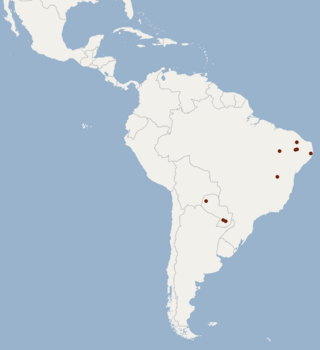
Paubrasilia echinata is a species of flowering plant in the legume family, Fabaceae, that is endemic to the Atlantic Forest of Brazil. It is a Brazilian timber tree commonly known as Pernambuco wood or brazilwood and is the national tree of Brazil. This plant has a dense, orange-red heartwood that takes a high shine, and it is the premier wood used for making bows for stringed instruments. The wood also yields a historically important red dye called brazilin, which oxidizes to brazilein.

The yellow-bellied elaenia is a small bird of the tyrant flycatcher family. It breeds from southern Mexico and the Yucatán Peninsula through Central and South America as far as northern Argentina, and on Trinidad and Tobago.

Salesópolis is a municipality in the state of São Paulo in Brazil. It is part of the Metropolitan Region of São Paulo. The population is 17,252 in an area of 424.997 km². Salesópolis sits at an elevation of 850 metres (2,790 ft). It is noted for being the source of the Tietê River.

The fringed fruit-eating bat, is a species of bat native to South America.

The long-tailed woodnymph is a species of hummingbird in the family Trochilidae. It is found in humid forest in northeastern Brazil, where it is known from the states of Pernambuco, Alagoas, Sergipe and the northernmost Bahia. It is usually thought to be widespread, but seen at low density in its increasingly fragmented range. Its population is estimated to be around 1,000–2,500 individuals, currently in decline due to deforestation and habitat loss.

Trachycephalus mesophaeus is a species of frog in the family Hylidae. It is endemic to eastern Brazil and occurs in the Atlantic Forest between Pernambuco and Rio Grande do Sul, extending inland to central Minas Gerais. It is found at elevations below 800 m (2,600 ft). Common name Porto Alegre golden-eyed treefrog has been coined for it, Porto Alegre being its type locality.

Adelophryne baturitensis is a species of frog in the family Eleutherodactylidae. It is endemic to north-eastern Brazil and is known from its type locality, Serra de Baturité in the state of Ceará.
Brosimum glaziovii is a species of plant in the family Moraceae.
Campomanesia hirsuta is a species of plant in the family Myrtaceae. The plant is endemic to the Atlantic Forest ecoregion of southeastern Brazil, within Rio de Janeiro state. It is an IUCN Red List Endangered species, threatened by habitat loss.
Ficus calyptroceras is a species of fig in the family Moraceae, in Brazil.
Ficus lapathifolia is a species of plant in the family Moraceae. It is endemic to Mexico.
Ficus luschnathiana is a species of plant in the family Moraceae. It is found in Argentina, Brazil, Bolivia, Paraguay, and Uruguay.
Ficus pakkensis is a species of plant in the family Moraceae, native to tropical northern South America.
Ficus pallida is a species of plant in the family Moraceae. It is found in Brazil, Colombia, and eastern Bolivia. In Bolivia, it is one of a few closely related trees in the genus Ficus popularly known as bibosi.
Ficus panurensis is a species of plant in the family Moraceae. It is found in Brazil, Guyana, Suriname, and Venezuela.
Ficus roraimensis is a species of fig tree in the family Moraceae.
Ficus salzmanniana is a species of fig tree in the family Moraceae, native to Brazil.
Ficus ursina is a species of fig tree in the family Moraceae.

LaVal's myotis is a species of bat found in Brazil and Paraguay.
Coendou speratus, known locally as coandumirim and commonly as the dwarf porcupine, is small porcupine of the Coendou genus found in northeastern Brazil. This small porcupine has a long tail and a spiny appearance as its dorsal fur is not long. Its dorsal colouring is blackish which contrasts with the brownish tips of its quills. It is distinguished from Coendou nycthemera by its tricolored quills whereas nycthemera is bicoloured.









